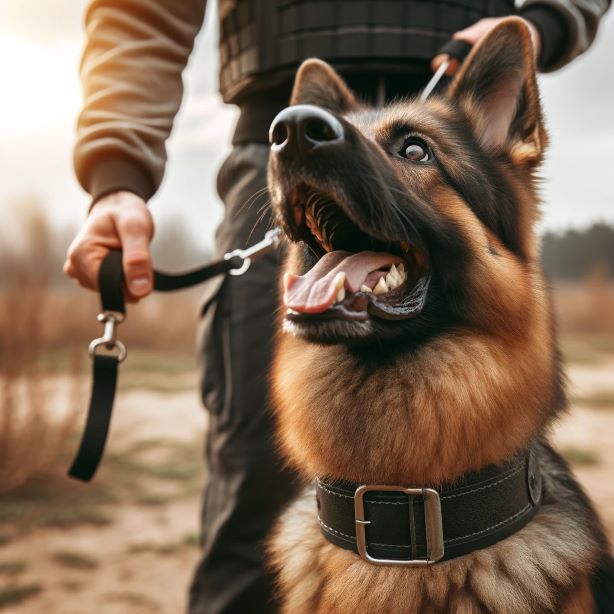How to Stop My Dog Barking When Out Walking?

How to Stop My Dog Barking When Out Walking? To know it read the full article.
Understanding and Addressing Excessive Dog Barking: A Guide for Pet Owners
Dog barking is a natural form of communication for our canine companions. However, when barking becomes excessive, it can be a source of frustration for both pet owners and neighbors. In this article, we’ll explore the reasons behind dog barking and offer practical tips to help you curb excessive barking behavior.
Understanding the Types of Barking
Dogs bark for various reasons, and identifying the type of barking is crucial for effective dog training. Also, the reasons behind a dog’s barking is the foundational step in developing an effective strategy for behavior modification. By recognizing the type of barking and the specific triggers, dog owners can tailor their training approaches to address the root causes of the behavior. This knowledge allows for a more targeted and successful training process, leading to a happier and quieter walking experience with your dog
Alert Barking:
Dogs often bark to alert their owners to potential threats or visitors. This type of barking is typically short-lived and stops once the perceived threat has passed.
Dogs, known for their keen senses and protective instincts, often communicate through barking. Alert barking is a distinctive form of vocalization that signals a dog’s awareness of a potential threat or change in their environment. In this article, we’ll delve into the nuances of alert barking, helping pet owners understand and interpret this behavior to enhance the bond with their vigilant companions.
Understanding the Nature of Alert Barking
Alert barking is a natural response rooted in a dog’s instinct to protect their territory and alert their pack to potential dangers. It is typically characterized by short, sharp bursts of barking, reflecting the dog’s heightened awareness and attention to a specific stimulus.

Recognizing the Vocalization Patterns of Alert barking
Sharp and Intermittent Barks: Alert barking often consists of quick, sharp barks that occur in rapid succession. The intermittent nature of the barking distinguishes it from other types of vocalizations.
Raised Ears and Tail: During alert barking, a dog’s ears are often erect, and the tail may be raised. These physical cues indicate the dog’s heightened focus and readiness.
Identifying Triggers for Alert Barking
Approaching Strangers: Dogs may alert bark when they sense unfamiliar people approaching their territory. This is a protective response, signaling to their owners that someone new is nearby.
Unusual Sounds: Dogs have sensitive hearing, and alert barking may be triggered by unexpected or unfamiliar sounds, such as footsteps, doorbells, or sirens.
Perceived Threats: Dogs may also alert bark in response to perceived threats, whether it’s a strange animal, an unfamiliar object, or a sudden movement in their environment.
Distinguishing Alert Barking from Other Types
Differentiating from Playful Barking: Alert barking can sometimes be mistaken for playful barking. However, the intensity and focus of alert barking set it apart, as it is directed towards a specific stimulus.
Contrasting with Fearful Barking: Fearful barking is characterized by a more anxious tone and body language. Alert barking, on the other hand, is confident and purposeful.

Responding Appropriately to Alert Barking
Acknowledge and Assess the Situation: When a dog engages in alert barking, it’s essential for owners to acknowledge the dog’s communication and assess the situation. This can involve checking for the presence of potential threats or unfamiliar stimuli.
Provide Positive Reinforcement: Once the threat has passed or the dog has alerted the owner, providing positive reinforcement, such as praise or a treat, can reinforce the desired behavior.
Fear Barking
Dogs, like humans, experience a range of emotions, and fear is a powerful motivator for certain behaviors, including barking. Fear barking is a distinctive vocalization that communicates a dog’s discomfort or anxiety in response to perceived threats. In this article, we’ll explore the nuances of fear barking, helping pet owners interpret and address this behavior to ensure the well-being of their anxious canine companions.
Understanding Fear Barking
Fear barking is a vocal expression of a dog’s anxiety or distress. It is characterized by a high-pitched and repetitive tone, reflecting the dog’s unease in response to a perceived threat.
Recognizing Vocalization Patterns
High-Pitched and Whining Sounds: Fear barking often involves higher-pitched and whining sounds compared to other types of barking. This indicates the dog’s emotional discomfort.
Continuous and Repetitive: Unlike alert barking, fear barking tends to be more continuous and repetitive, reflecting the dog’s heightened state of anxiety.
Identifying Triggers for Fear Barking
Loud Noises: Dogs may fear bark in response to sudden loud noises, such as thunderstorms, fireworks, or construction sounds.
Unfamiliar People or Animals: Fear barking can be triggered by encounters with strangers, unfamiliar animals, or new and intimidating stimuli.
Unpredictable Environments: Changes in the environment, such as moving to a new home or encountering novel objects, can provoke fear barking.
Body Language and Physical Cues
Tail Tucking: A fearful dog may tuck its tail between its legs as a sign of submission and anxiety.
Ears Back: Fearful barking is often accompanied by ears pinned back against the head, indicating discomfort and apprehension.
Crouching or Trembling: Physiological responses like crouching or trembling may accompany fear barking, signaling the dog’s heightened stress levels.
Distinguishing Fear Barking from Other Types
Contrasting with Playful Barking: Fear barking is distinct from playful barking, as it lacks the exuberance and excitement associated with play.
Differentiating from Alert Barking: While alert barking is purposeful and confident, fear barking is marked by uncertainty and anxiety.
Understanding and managing Fear Barking
Create a Safe Space: Provide a designated safe space where your dog can retreat when feeling anxious.
Positive Reinforcement: Use positive reinforcement techniques to create positive associations with fear-inducing stimuli.
Gradual Desensitization: Gradually expose your dog to fear triggers in a controlled manner to help them build confidence and reduce anxiety.
Excitement Barking
Dogs are naturally exuberant creatures, and one way they express their enthusiasm is through excitement barking. While this form of vocalization is often a sign of a happy and lively pup, excessive excitement barking can pose challenges for pet owners. In this article, we’ll explore the dynamics of excitement barking, helping dog owners interpret and manage this energetic behavior to ensure harmonious interactions with their spirited companions.
Defining Excitement Barking:
Excitement barking is a canine expression of joy, anticipation, or eagerness. It is characterized by rapid, high-pitched barks that reflect a dog’s enthusiastic state.
Recognizing Vocalization Patterns:
Rapid and High-Pitched: Excitement barking is typically characterized by a series of quick, high-pitched barks. This reflects the dog’s heightened arousal and joy.
Accompanied by Wagging Tail: A wagging tail, often held high, is a physical manifestation of a dog’s excitement and positive anticipation.
Identifying Triggers for Excitement Barking
Pre-Walk Anticipation: Dogs may bark with excitement before walks, expressing eagerness to explore the outdoors.
Mealtime Excitement: The prospect of mealtime can trigger excitement barking as dogs eagerly await their food.
Playtime and Interactions: During play or when anticipating interaction with their owners, dogs may engage in excitement barking.
Physical Cues and Body Language:
Jumping and Bouncing: Excitement barking is often accompanied by physical expressions such as jumping, bouncing, or running in circles.
Pawing and Nudging: Dogs may express excitement through pawing or nudging, seeking attention and interaction.

Distinguishing Excitement Barking from Other Types:
Contrasting with Alert Barking: Unlike alert barking, which is purposeful and focused, excitement barking is characterized by a more carefree and exuberant tone.
Differentiating from Fear Barking: Fearful barking has a higher-pitched, anxious tone, while excitement barking is marked by a more positive and eager demeanor.
Managing Excitement Barking
Training Commands: Teach your dog commands like “quiet” or “enough” through positive reinforcement to control excitement barking.
Redirecting Attention: Provide toys or treats to redirect your dog‘s attention during particularly exciting moments.
Consistent Reinforcement: Reinforce calm behavior with positive attention and treats, encouraging a balanced expression of excitement.
Here’s a table listing different types of dogs and corresponding strategies to control their barking or how to stop nuisance Barking dog
| Type of Dog | Nuisance Barking Control Strategies | |
| Small Breeds (e.g., Chihuahua, Yorkie) | 1. Positive Reinforcement: Use treats and praise to reinforce quiet behavior. 2. Provide Toys: Offer small, engaging toys to keep them occupied. | |
| Guardian Breeds (e.g., German Shepherd, Rottweiler) | 1. Training Commands: Teach commands like “enough” for better control. 2. Socialization: Expose them to various stimuli to reduce over-protective barking. | |
| Herding Breeds (e.g., Border Collie, Australian Shepherd) | 1. Physical Exercise: Ensure they get ample exercise to reduce excess energy. 2. Mental Stimulation: Engage in activities that challenge their intelligent minds. | |
| Terrier Breeds (e.g., Jack Russell Terrier, Bull Terrier) | 1. Digging Outlet: Terriers may bark due to boredom; provide a designated digging area. 2. Structured Play: Offer structured play to channel their high energy positively. | |
| Hunting Breeds (e.g., Beagle, Coonhound) | 1. Scent Work: Engage them in scent-related activities to satisfy their natural instincts. 2. Regular Exercise: Ensure they have sufficient physical exercise to reduce boredom barking. | |
| Companion Breeds (e.g., Shih Tzu, Cavalier King Charles Spaniel) | 1. Comfort Items: Provide comfort items when they may feel anxious or lonely. 2. Attention and Affection: Frequent affection can help alleviate attention-seeking barking. | |
| Toy Breeds (e.g., Pomeranian, Maltese) | 1. Gentle Correction: Use a calm voice to discourage excessive barking. 2. Interactive Toys: Keep them engaged with interactive toys to reduce boredom barking. | |
| Sighthounds (e.g., Greyhound, Whippet) | 1. Satisfy Curiosity: Sighthounds may bark at moving objects; satisfy their curiosity with safe observations. 2. Daily Runs: Regular runs can help burn excess energy and reduce barking. | |
| Working Breeds (e.g., Boxer, Doberman Pinscher) | 1. Obedience Training: Enroll in obedience classes to establish control. 2. Job Assignments: Provide tasks or jobs to keep their minds occupied. | |
| Utility Breeds (e.g., Bulldog, Dalmatian) | 1. Comfort Measures: Bulldogs may bark when uncomfortable; ensure their environment is comfortable. 2. Gentle Discipline: Use gentle discipline to discourage unnecessary barking. | |
| Water Retrievers (e.g., Labrador Retriever, Golden Retriever) | 1. Water Activities: Engage them in water-related activities to satisfy their natural instincts. 2. Positive Socialization: Encourage positive interactions to reduce barking at strangers. | |
| Northern Breeds (e.g., Siberian Husky, Alaskan Malamute) | 1. Cooling Measures: Huskies may bark when overheated; provide cooling options. 2. Sled Pulling: Engage in activities like sled pulling to channel their energy. | |
| Livestock Guardian Dogs (e.g., Great Pyrenees, Anatolian Shepherd) | 1. Guarded Space: Create a designated space for them to guard, reducing territorial barking. 2. Quiet Command: Train them to respond to a “quiet” command effectively. | |
| Companion Sport Breeds (e.g., Cocker Spaniel, Papillon) | 1. Agility Training: Channel their energy through agility training and activities. 2. Regular Playdates: Organize playdates to fulfill their social needs and reduce barking. | |
Remember, individual dogs may vary, and it’s essential to tailor your approach based on the specific needs and personality of your furry friend. Additionally, consistent training and positive reinforcement play a crucial role in managing and controlling barking behavior across all types of dogs.
Conclusion
Curtailing nuisance barking or how to stop dog barking at strangers requires a combination of understanding, consistent training, and positive reinforcement. By identifying triggers, employing distraction techniques, and establishing a quiet command, pet owners can work towards reducing excessive vocalization and fostering a quieter, more enjoyable living environment for both dogs and their human companions. Patience and dedication to training are essential components in achieving long-term success in curbing nuisance barking.
faq
Why does my dog bark while out walking?
Dogs bark during walks for various reasons including excitement, fear, territorial behavior, or as a response to stimuli like other animals or people.
How can I prevent my dog from barking at other dogs?
Work on socialization to make your dog more comfortable around others. Use positive reinforcement to reward calm behavior and practice focus exercises.
What training methods can help stop barking on walks?
Training methods include desensitization to triggers and teaching ‘quiet’ commands. Consistency and patience are key. Avoid negative reinforcement which can increase anxiety.
Can certain equipment help reduce barking during walks?
Yes, head collars or harnesses can provide better control. Avoid choke or shock collars, as these can cause harm and increase stress and barking.
Should I use treats to stop my dog from barking?
Treats can be effective if used as positive reinforcement for silence or attention. However, ensure not to reward barking inadvertently.
What if my dog barks at people during walks?
Similar to dealing with barking at other dogs, increase distance from people until your dog is calmer, reinforcing quiet behavior with treats and praise.
Is it okay to tell my dog off for barking?
While it’s okay to give a firm ‘no’, don’t shout. Dogs may interpret shouting as joining in, which can reinforce the behavior.
Could my dog’s barking be due to a lack of exercise?
Yes, insufficient exercise can lead to pent-up energy that manifests as barking. Ensure your dog is getting enough physical and mental stimulation.
What should I do if nothing stops the barking?
If persistent, consult a professional dog trainer or behaviorist. There may be underlying issues that need expert attention.
Is there ever a time when I should allow my dog to bark on walks?
Barking can be a form of communication. If your dog is alerting you to a genuine concern, it may be appropriate to investigate rather than discourage.
Related posts:
Read more: Why Does My Dog Steals My Clothes: And Learn How To Stop It
Read more: Just how much should you feed a dog to remain healthy?
Read more: Why Does My Dog Steals My Clothes: And Learn How To Stop It
Read more: WHY DOES MY DOG GROWL AT ME IN THE MORNING
Read more: Why Does My Dog Put His Paw On My Face?


